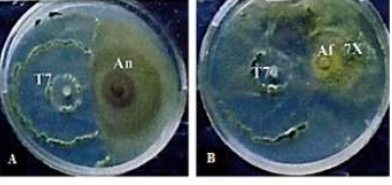GROWTH INHIBITION OF ROT FUNGI BY COMPETITIVE GROWTHOF TRICHODERMA VIRIDE
Keywords:
T.viride, Biocontrol, rot fungi, dual cultureAbstract
A study was carried out in vitro to evaluate the antagonistic growth potential of a Trichoderma viride strain in the biological control of some common post-harvest and storage rot fungi of food crops. The experiment was set up in Completely Randomized Design (CRD) with three treatments and two replicates. Data obtained were analyzed by Analysis of Variance (ANOVA) at 5 % level of probability using SPSS software version seventeen. 5 mm diameter agar discs of 2-7 days old cultures of antagonist and rot fungi obtained using a sterile 5mm diameter cork borer were cultured simultaneously in dual cultures on Potato Dextrose Agar (PDA) in 8.5 mm diameter petri dishes and incubated for a total duration of 9 days at 280C. Radial growth inhibition of rot fungi increased steadily from the 1st to the 9th day of post-inoculation. Radial growth of Aspergillus flavus was inhibited the most (42.94 %), followed by Aspergillus niger (30.88%) and lastly Fusarium oxysporum (30.65 %). In pairing with A. flavus, massive sporulation of T. viride on growth surface of rot fungus was accompanied with extensive degradation of mycelia of A. flavus by T. viride after 9 days post-inoculation. Zones of mycelia growth inhibition were observed in dual cultures of T. viride with A. flavus and F. oxysporum. Differences in growth inhibition of rot fungi by T. viride were significant (P<0.05) except between pairing with A. niger and F. oxysporum. The T. viride strain used in the study exhibited significant biocontrol potential through competitive growth against the test fungi and could be applied in biocontrol of rot fungi in storage as a means of enhancing shelf life as well as preserving the market value of harvested farm produce.
Downloads





